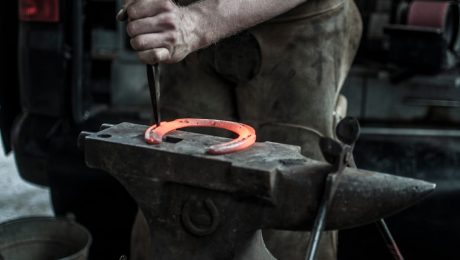The automotive industry, construction sector, and countless other manufacturing fields rely heavily on Original Equipment Manufacturer (OEM) steel components. These are the crucial parts, often unseen, that form the backbone of countless products. Understanding the intricacies of their production is key to comprehending the supply chains and technological advancements driving modern manufacturing.
1. The Steel Selection Process: Choosing the Right Material for the Job
Selecting the appropriate steel grade is paramount in OEM steel component production. The choice depends on a multitude of factors including the component’s intended application, required strength, durability, and cost considerations. Different steel grades possess varying properties: some excel in tensile strength, others in impact resistance, and still others in corrosion resistance. For example, high-carbon steel might be ideal for high-stress applications like crankshafts in engines, while low-carbon steel might suffice for less demanding parts. The selection process often involves rigorous material testing and simulations to ensure the chosen steel meets and exceeds performance expectations. This stage also involves careful consideration of potential environmental impacts and the sustainability of the chosen steel grade.
2. Manufacturing Processes: From Raw Material to Finished Component
OEM steel component production utilizes a diverse range of manufacturing processes, each tailored to the specific design and required properties of the component. Common methods include:
- Forging: This process involves shaping the steel using compressive forces, resulting in high strength and density. Forging can be performed hot or cold, depending on the steel grade and desired outcome.
- Casting: Molten steel is poured into a mold, allowing it to solidify into the desired shape. Casting is suitable for complex shapes but may result in lower strength compared to forging.
- Rolling: Steel is passed through rollers to reduce its thickness and create a desired shape. This method is efficient for producing long, consistent parts.
- Machining: This subtractive manufacturing process uses tools to remove material from a pre-formed component to achieve precise dimensions and surface finishes. CNC machining allows for highly accurate and complex parts.
- Stamping: Sheet metal is formed into shapes using dies. This process is highly efficient for mass production of relatively simple parts.
The selection of the manufacturing process is crucial for optimizing cost, efficiency, and product quality. Often, a combination of processes is employed to achieve the desired outcome.
3. Quality Control and Assurance: Ensuring Consistent Excellence
Maintaining stringent quality control throughout the entire production process is crucial for OEM steel component production. This involves regular inspections at various stages, from incoming raw material inspection to final product testing. Methods employed include:
- Dimensional inspection: Verifying that the component’s dimensions conform to the specified tolerances.
- Material testing: Assessing the mechanical properties of the steel, such as tensile strength, yield strength, and hardness.
- Non-destructive testing (NDT): Utilizing techniques like ultrasonic testing, radiographic testing, and magnetic particle inspection to detect internal flaws without damaging the component.
- Surface finish inspection: Evaluating the surface quality for imperfections, such as scratches, pitting, or corrosion.
- Statistical Process Control (SPC): Using statistical methods to monitor and control the manufacturing process, minimizing variation and ensuring consistent quality.
Robust quality control procedures are essential for ensuring the reliability and safety of the final product and maintaining the reputation of the OEM.
4. The Role of Automation and Advanced Technologies
The OEM steel component production industry is undergoing a significant transformation driven by automation and advanced technologies. Robotics, AI, and machine learning are being increasingly integrated into various stages of the production process, leading to improved efficiency, precision, and consistency. For instance, automated guided vehicles (AGVs) can transport materials and components, while robotic arms can perform complex machining operations with greater speed and accuracy than human workers. Furthermore, advanced simulation and modeling tools allow for the optimization of manufacturing processes and the prediction of potential problems before they occur. The adoption of Industry 4.0 principles is driving a shift towards smart factories, where data is collected and analyzed in real-time to optimize production and improve overall efficiency.
5. The Future of OEM Steel Component Production: Sustainability and Innovation
The future of OEM steel component production is shaped by two key drivers: sustainability and innovation. The industry is increasingly focused on reducing its environmental impact through the use of recycled steel, energy-efficient manufacturing processes, and the reduction of waste. Innovation is also playing a crucial role, with the development of new steel alloys with enhanced properties, such as higher strength-to-weight ratios and improved corrosion resistance. Additive manufacturing (3D printing) is emerging as a promising technology for the production of complex steel components, offering greater design flexibility and reduced material waste. The integration of advanced materials, such as composites and high-strength lightweight alloys, alongside steel, is also expected to play a significant role in shaping the future of the industry. The focus will remain on producing high-quality, cost-effective, and sustainable components that meet the ever-evolving demands of various industries.
Tags: OEM steel components, steel component manufacturing, steel production, automotive steel parts, metal fabrication
Galvanized steel, a ubiquitous material in construction, infrastructure, and manufacturing, owes its widespread use to its exceptional corrosion resistance. This article delves into the science behind this remarkable property, exploring the process, factors influencing its longevity, and the diverse applications where it shines.
The Galvanization Process: A Protective Shield
The secret to galvanized steel’s resilience lies in the galvanization process itself. This involves coating steel with a layer of zinc, typically through hot-dip galvanizing, a process where steel components are immersed in a molten zinc bath. This creates a metallurgical bond between the zinc and the steel, forming a robust, durable coating. The thickness of this zinc coating is crucial; thicker coatings provide longer-lasting protection. Other methods exist, such as electrogalvanizing (where zinc is electroplated onto the steel), but hot-dip galvanizing generally offers superior corrosion resistance due to the thicker and more robust zinc layer.
The process not only provides a physical barrier against corrosive agents but also leverages the electrochemical properties of zinc. Zinc is more reactive than steel, meaning it preferentially corrodes, acting as a sacrificial anode. This means that even if the zinc coating is scratched or damaged, the underlying steel remains protected. The zinc continues to corrode, protecting the steel until the zinc is completely depleted.
How Zinc Protects Steel: The Science of Sacrificial Anodes
The electrochemical protection offered by zinc is a key factor in galvanized steel’s superior corrosion resistance. This is explained by the concept of sacrificial anodes. In the presence of moisture and oxygen, a galvanic cell is formed between the zinc coating and the steel substrate. Zinc, being more electropositive than iron (the primary component of steel), readily loses electrons, forming zinc ions (Zn2+). These electrons flow to the steel, preventing the iron from oxidizing and forming rust. This process continues until the zinc is completely consumed, providing long-term protection to the steel even after significant coating degradation.
The effectiveness of this sacrificial protection depends on several factors, including the thickness of the zinc coating, the environmental conditions (humidity, salinity, pollution), and the presence of other metals that might alter the electrochemical reactions.
Factors Affecting the Lifespan of Galvanized Steel
While galvanized steel offers excellent corrosion resistance, its lifespan isn’t indefinite. Several factors influence its longevity. Environmental conditions play a significant role. Highly corrosive environments, such as coastal areas with high salinity or industrial areas with high levels of air pollution, can accelerate corrosion. The thickness of the zinc coating is also critical; thicker coatings provide significantly longer protection. The quality of the galvanizing process itself is paramount, ensuring a uniform and defect-free coating is crucial for optimal performance.
Furthermore, the type of steel substrate also impacts the overall corrosion resistance. The composition and surface finish of the steel before galvanization can influence the adhesion and performance of the zinc coating. Proper surface preparation is essential to maximize the longevity of the galvanized steel.
Applications Where Galvanized Steel Excels
The exceptional corrosion resistance of galvanized steel makes it ideal for a vast array of applications. In construction, it’s widely used for roofing, cladding, fencing, and structural components. Its durability and longevity make it a cost-effective solution for long-term projects. In infrastructure, galvanized steel is employed in bridges, pipelines, and other outdoor structures exposed to harsh environmental conditions. The automotive industry utilizes galvanized steel for body panels and other components, improving the vehicle’s lifespan and reducing the need for frequent repairs.
Other applications include: agricultural equipment, storage tanks, transmission towers, and various industrial components. The versatility and corrosion resistance of galvanized steel make it a preferred material across numerous sectors.
Maintaining and Extending the Lifespan of Galvanized Steel
While galvanized steel is inherently durable, proper maintenance can significantly extend its lifespan. Regular cleaning can remove accumulated dirt, debris, and corrosive substances that might accelerate corrosion. In harsh environments, applying protective coatings over the galvanized surface can provide additional protection. Avoiding damage to the zinc coating is crucial; minimizing scratches and abrasions during handling and installation prevents premature corrosion. Regular inspections can identify any signs of corrosion early on, allowing for timely repairs or maintenance to prevent extensive damage.
Understanding the factors influencing the corrosion resistance of galvanized steel allows for informed material selection and proper maintenance practices, maximizing its lifespan and ensuring its continued effectiveness in diverse applications.
Tags: galvanized steel, corrosion resistance, zinc coating, hot-dip galvanizing, steel protection
The steel industry, a cornerstone of global infrastructure and manufacturing, faces a monumental challenge: achieving net-zero carbon emissions. This seemingly insurmountable task requires a radical transformation of production processes, a shift towards innovative technologies, and a collaborative effort across the entire value chain. This post delves into the complexities of achieving net-zero targets in steel production, exploring the hurdles and highlighting the promising pathways forward.
The Urgent Need for Decarbonization in Steelmaking
Steel production is notoriously carbon-intensive. The traditional blast furnace-basic oxygen furnace (BF-BOF) route relies heavily on coking coal, a major source of greenhouse gas emissions. This process accounts for approximately 7% of global CO2 emissions, making it a critical target for climate action. The urgency stems not only from the environmental imperative but also from increasing regulatory pressure and growing investor scrutiny. Many countries are implementing carbon pricing mechanisms and setting ambitious emission reduction targets, putting immense pressure on steel producers to decarbonize or face significant financial penalties and market disadvantages. The transition to net-zero is not just an environmental goal; it’s a business imperative for survival and long-term sustainability.
Exploring Alternative Steelmaking Technologies
The path to net-zero steel hinges on the adoption of alternative steelmaking technologies that significantly reduce or eliminate reliance on fossil fuels. Several promising pathways are emerging:
- Hydrogen Direct Reduction (HDR): This process uses hydrogen instead of coal to reduce iron ore, drastically reducing CO2 emissions. However, the availability of green hydrogen, produced through renewable energy sources, remains a significant challenge. Cost-effectiveness and scalability are also crucial factors for widespread adoption.
- Electric Arc Furnaces (EAFs): EAFs utilize electricity to melt scrap steel, significantly lowering emissions compared to BF-BOF. However, their reliance on the availability of sufficient scrap steel limits their potential for complete decarbonization. Improving scrap metal recycling infrastructure and practices is crucial for maximizing the impact of EAFs.
- Carbon Capture, Utilization, and Storage (CCUS): CCUS technologies capture CO2 emissions from steelmaking processes and either store them underground or utilize them in other industrial applications. While CCUS can play a crucial role in reducing emissions from existing facilities, its high cost and energy requirements remain significant barriers to widespread implementation. Furthermore, concerns about the long-term safety and security of CO2 storage need addressing.
- Bio-based reduction agents: Research is underway exploring the use of bio-based materials, such as biomass, as alternative reducing agents in steelmaking. While promising in terms of carbon neutrality, the scalability and efficiency of these processes need further development.
The Role of Renewable Energy and Energy Efficiency
Regardless of the chosen steelmaking technology, transitioning to renewable energy sources is paramount. The energy intensity of steel production is high, and decarbonizing the energy supply is crucial for achieving net-zero. This involves a massive investment in renewable energy infrastructure, including solar, wind, and hydropower, to power steel mills and produce green hydrogen. Furthermore, improving energy efficiency across the entire steelmaking process is essential. This includes optimizing production processes, implementing advanced control systems, and utilizing waste heat recovery technologies. These measures can significantly reduce the overall energy consumption and consequently the carbon footprint of steel production.
Supply Chain Collaboration and Policy Support
Achieving net-zero steel requires a collaborative effort across the entire value chain. Steel producers, energy suppliers, technology providers, and policymakers must work together to create a supportive ecosystem for decarbonization. This includes establishing clear policy frameworks, providing financial incentives for the adoption of low-carbon technologies, and fostering research and development in innovative solutions. Collaboration is also crucial for securing the supply of green hydrogen and other low-carbon inputs, as well as managing the challenges associated with waste management and recycling.
Challenges and Opportunities in Achieving Net-Zero Steel
The transition to net-zero steel presents significant challenges. The high capital costs associated with new technologies, the need for large-scale infrastructure investments, and the complexity of integrating different decarbonization pathways are major hurdles. However, significant opportunities also exist. The development and deployment of low-carbon steel technologies will create new jobs and economic opportunities, stimulate innovation, and enhance the competitiveness of steel producers. Furthermore, achieving net-zero steel will contribute significantly to global climate goals and pave the way for a more sustainable and resilient future.
The journey towards net-zero steel is ambitious but necessary. By embracing innovative technologies, fostering collaboration, and implementing supportive policies, the steel industry can forge a greener future and contribute to a more sustainable world.
In today’s competitive marketplace, trust is paramount. Consumers, businesses, and regulatory bodies demand assurance that products and services meet specified standards, perform as advertised, and pose no undue risk. This assurance is delivered through comprehensive testing and the subsequent issuance of test reports and certifications. This guide delves into the crucial role of these documents, explaining their significance and providing insights into navigating the complexities of this critical area.
Understanding the Importance of Test Reports
Test reports are the bedrock of product validation and verification. They are detailed documents that meticulously record the results of various tests performed on a product, process, or system. These tests can range from simple functionality checks to complex simulations designed to assess durability, safety, and performance under extreme conditions. A well-structured test report includes:
- Test objective: Clearly stating the purpose of the testing.
- Methodology: Detailing the procedures and standards followed.
- Test environment: Describing the conditions under which the tests were conducted.
- Results: Presenting the findings in a clear and concise manner, often with tables, graphs, and images.
- Conclusion: Summarizing the overall findings and assessing whether the product or system met the predefined criteria.
- Date and signature of the testing personnel: Ensuring accountability and traceability.
The importance of a thorough and accurate test report cannot be overstated. It serves as irrefutable evidence of a product’s capabilities and its compliance with relevant regulations. It protects manufacturers from liability, builds consumer confidence, and facilitates smooth market entry.
The Significance of Certifications
While test reports provide detailed evidence of testing results, certifications take this a step further by providing independent verification of a product’s conformance to specific standards. Certifications are issued by accredited third-party organizations after rigorous audits and assessments. These organizations, often recognized internationally, ensure impartiality and credibility.
Certifications are crucial for several reasons:
- Demonstrates compliance: Provides demonstrable proof of adherence to industry standards and regulatory requirements.
- Enhances credibility: Inspires consumer trust and confidence in the product’s quality and safety.
- Facilitates market access: Many markets require specific certifications before a product can be sold legally.
- Reduces risk: Minimizes the risk of product recalls, legal battles, and reputational damage.
- Competitive advantage: Having recognized certifications can provide a significant competitive edge in the marketplace.
Examples of common certifications include ISO 9001 (quality management), ISO 14001 (environmental management), and various safety certifications specific to different industries.
Navigating Different Types of Tests and Reports
The types of tests and corresponding reports vary widely depending on the product, industry, and regulatory requirements. Some common types include:
- Functional testing: Verifying that the product performs its intended functions correctly.
- Performance testing: Evaluating the speed, efficiency, and scalability of the product.
- Security testing: Assessing the product’s vulnerability to cyberattacks and data breaches.
- Compliance testing: Ensuring the product meets all relevant regulatory requirements and standards.
- Stress testing: Determining the product’s ability to withstand extreme conditions and heavy loads.
- Usability testing: Evaluating the ease of use and user experience.
Each test type generates a specific report tailored to its objectives and findings. Understanding the nuances of different test types is crucial for selecting the appropriate tests and interpreting the results accurately.
Ensuring the Validity and Reliability of Test Reports and Certifications
The credibility of test reports and certifications hinges on the integrity and competence of the testing laboratory and certifying body. It is essential to choose accredited and reputable organizations that adhere to strict quality control procedures. Look for organizations that:
- Are accredited by recognized bodies: Accreditation ensures that the organization meets international standards for competence and impartiality.
- Have a proven track record: Check the organization’s reputation and experience in the relevant industry.
- Utilize state-of-the-art equipment: Modern equipment ensures accurate and reliable test results.
- Employ qualified personnel: Experienced and knowledgeable personnel are crucial for conducting tests correctly and interpreting results accurately.
- Maintain detailed records: Proper record-keeping is essential for traceability and auditability.
The Future of Test Reports and Certifications
The landscape of testing and certification is constantly evolving, driven by technological advancements and increasing regulatory scrutiny. We are seeing a growing emphasis on:
- Digitalization: Increased use of digital tools and platforms for managing and sharing test reports and certifications.
- Blockchain technology: Exploring the use of blockchain to enhance the security and transparency of certification processes.
- Artificial intelligence (AI): Leveraging AI to automate testing processes and analyze large datasets.
- Sustainability: Growing focus on environmental impact and the development of eco-friendly testing methods.
- Cybersecurity: Increased attention to the security of testing data and systems.
Staying abreast of these trends is crucial for manufacturers and businesses to maintain compliance, build trust, and remain competitive in the global market.
In conclusion, test reports and certifications are indispensable components of product development, quality assurance, and market success. By understanding their significance, navigating the different types available, and selecting reputable organizations, businesses can leverage these tools to build trust, meet regulatory requirements, and achieve sustainable growth.
SEO Tags: test reports, certifications, quality assurance, ISO certification, regulatory compliance
body {
font-family: sans-serif;
line-height: 1.6;
}
h1, h2, h3 {
color: #333;
}
The construction industry is undergoing a significant transformation, driven by the need for sustainable, efficient, and cost-effective building solutions. Hybrid construction techniques, which cleverly combine traditional and modern building methods, are emerging as a leading approach to meet these demands. This innovative approach offers a unique blend of strengths, mitigating the weaknesses of individual methods and creating structures that are both robust and environmentally conscious.
Understanding the Essence of Hybrid Construction
Hybrid construction isn’t simply using two different materials; it’s a strategic integration of their properties to optimize the building’s performance. This could involve combining timber frames with concrete infills, steel structures with prefabricated modular components, or even incorporating recycled materials into the mix. The core principle is synergy – leveraging the best qualities of each component to create a superior whole. For instance, timber’s lightweight nature and excellent insulation properties can be combined with concrete’s strength and fire resistance, resulting in a building that’s both energy-efficient and structurally sound. This approach opens up a world of design possibilities, allowing architects and engineers to push creative boundaries while remaining mindful of practical considerations.
Popular Hybrid Construction Combinations: A Closer Look
Several successful hybrid combinations are gaining traction in the construction industry. One prevalent example is the integration of timber frames with concrete or steel elements. Timber frames provide a rapid and cost-effective structure, while concrete or steel components enhance strength and fire resistance, particularly in load-bearing areas. This approach is often employed in multi-story buildings where a balance between speed, cost, and structural integrity is crucial. Another increasingly popular combination involves using prefabricated modular components with traditional in-situ construction. Prefabrication allows for faster construction times and better quality control in a controlled factory environment, while in-situ work allows for flexibility and customization on-site. This hybrid approach efficiently combines the advantages of both methods. Steel and concrete are also frequently combined, leveraging steel’s tensile strength for framing and concrete’s compressive strength for slabs and walls, creating robust and long-lasting structures.
Benefits of Embracing Hybrid Construction Methods
The advantages of hybrid construction are numerous and compelling. Firstly, it offers increased design flexibility, allowing architects to explore unconventional designs and incorporate innovative features. Secondly, it significantly reduces construction time compared to traditional methods, leading to faster project completion and reduced overall costs. Thirdly, it enhances the sustainability of buildings. Using materials like timber, which is a renewable resource, reduces the environmental impact compared to relying solely on concrete or steel. Furthermore, hybrid construction often results in improved energy efficiency. The strategic combination of materials can optimize insulation and reduce energy consumption throughout the building’s lifecycle. Finally, it can lead to improved structural performance, combining the strengths of different materials to create a more resilient and durable building.
Challenges and Considerations in Hybrid Construction
Despite its numerous advantages, hybrid construction presents some challenges. One key consideration is the need for skilled labor proficient in handling multiple construction techniques. Effective collaboration between different trades is essential to ensure seamless integration of various components. Another challenge lies in the design phase, requiring careful planning and coordination to ensure compatibility between different materials and construction methods. Accurate cost estimations can also be more complex due to the involvement of multiple materials and techniques. Finally, regulatory compliance can be more intricate as it involves navigating the requirements for different building materials and construction processes. Addressing these challenges requires thorough planning, meticulous execution, and a deep understanding of the properties of each material and construction method involved.
The Future of Hybrid Construction: Trends and Innovations
The future of hybrid construction looks bright, with continuous advancements in materials science and construction technology driving innovation. We can expect to see an increasing adoption of sustainable materials, such as bamboo and recycled materials, integrated into hybrid designs. Furthermore, the integration of advanced technologies, such as Building Information Modeling (BIM) and digital fabrication, will further streamline the design and construction process, enhancing efficiency and precision. The use of Artificial Intelligence (AI) in optimizing material selection and construction sequencing will also play a significant role in improving the overall performance and sustainability of hybrid structures. These advancements will allow for the creation of even more innovative, efficient, and sustainable buildings, shaping the future of the construction industry.
Tags: Hybrid Construction, Sustainable Building, Modern Construction, Timber Frame Construction, Green Building
The steel industry, a cornerstone of global infrastructure and manufacturing, is undergoing a dramatic transformation fueled by digitalization. This revolution extends far beyond simple automation, impacting every aspect of steel commerce, from raw material sourcing to final product delivery. This post delves into the key ways digital technologies are reshaping the landscape of the global steel market.
1. Optimizing the Steel Supply Chain with Digital Tools
The steel supply chain is notoriously complex, involving numerous intermediaries, geographically dispersed operations, and fluctuating demand. Digitalization offers powerful solutions to streamline this intricate process. Real-time tracking of materials using RFID tags and IoT sensors provides unparalleled visibility, allowing companies to anticipate bottlenecks, optimize inventory levels, and reduce lead times. Advanced analytics, powered by big data, can predict market fluctuations and optimize logistics routes, leading to significant cost savings and improved efficiency. Furthermore, digital platforms facilitate seamless communication and collaboration between different stakeholders, enhancing transparency and trust throughout the supply chain.
2. Enhancing Steel Trading and E-commerce Platforms
Traditional steel trading often relies on lengthy negotiation processes and manual paperwork. Digital platforms are changing this by providing a streamlined, efficient, and transparent marketplace for steel products. E-commerce solutions offer real-time price updates, automated order processing, and secure payment gateways, significantly reducing transaction costs and time. These platforms also facilitate global reach, connecting buyers and sellers across geographical boundaries. The integration of AI-powered recommendation engines can further enhance the user experience by suggesting relevant products and optimizing pricing strategies.
3. Leveraging Big Data and Analytics for Smarter Decision-Making
The steel industry generates massive amounts of data from various sources, including production processes, sales transactions, and market trends. Big data analytics provide the tools to extract valuable insights from this data, enabling businesses to make more informed decisions. Predictive analytics can forecast demand, optimize production schedules, and identify potential risks. Data visualization dashboards provide clear, concise summaries of key performance indicators (KPIs), facilitating better monitoring and control of operations. By leveraging the power of big data, steel companies can improve efficiency, reduce waste, and gain a competitive advantage.
4. Implementing Blockchain for Enhanced Transparency and Security
Blockchain technology offers a secure and transparent way to track the origin and movement of steel products throughout the supply chain. This can be particularly beneficial in combating counterfeit materials and ensuring the ethical sourcing of raw materials. By recording all transactions on a distributed ledger, blockchain enhances traceability and accountability, building trust among all stakeholders. Smart contracts can automate certain processes, such as payments and delivery confirmations, further improving efficiency and reducing the risk of disputes.
5. The Role of Artificial Intelligence (AI) in Steel Production and Sales
AI is rapidly transforming various aspects of the steel industry. In production, AI-powered systems can optimize processes, predict equipment failures, and improve quality control. AI algorithms can analyze vast amounts of data to identify patterns and anomalies, leading to improved efficiency and reduced downtime. In sales and marketing, AI can personalize customer interactions, optimize pricing strategies, and predict customer demand. Chatbots can provide instant customer support, while AI-powered recommendation engines can suggest relevant products and services, enhancing customer satisfaction and loyalty.
The digital transformation of the steel industry is an ongoing process, with new technologies constantly emerging and evolving. By embracing these advancements, steel companies can improve efficiency, reduce costs, enhance customer relationships, and gain a significant competitive advantage in the global marketplace. The future of steel commerce is undeniably digital, and those who adapt quickly will thrive.
SEO-Friendly Tags:
- Digitalization in Steel
- Steel Industry 4.0
- Steel Supply Chain Optimization
- Steel E-commerce
- Blockchain in Steel
High-pressure piping systems are essential components in numerous industries, from oil and gas to chemical processing and power generation. However, the inherent risks associated with high-pressure systems demand meticulous attention to safety. A failure in a high-pressure pipe can lead to catastrophic consequences, including injury, environmental damage, and significant financial losses. This guide delves into the critical aspects of ensuring the safe operation of high-pressure piping systems.
1. Material Selection: The Foundation of High-Pressure Pipe Safety
The choice of pipe material is paramount. The material must possess the necessary strength, ductility, and corrosion resistance to withstand the operating pressure, temperature, and the nature of the fluid being transported. Common materials include carbon steel, stainless steel, alloy steel, and various plastics (depending on the application and pressure). Each material has its own limitations and suitability for specific applications. Factors to consider include:
- Yield Strength: The material’s resistance to permanent deformation under stress.
- Tensile Strength: The maximum stress a material can withstand before breaking.
- Corrosion Resistance: The material’s ability to resist degradation from the transported fluid or the environment.
- Temperature Resistance: The material’s ability to maintain its properties at elevated temperatures.
- Weldability: The ease with which the material can be joined using welding techniques.
Careful material selection, based on detailed engineering calculations and industry standards, is crucial to prevent failures due to material inadequacy.
2. Regular Inspection and Maintenance: Preventing Catastrophic Failures
Regular inspection and maintenance are vital for identifying potential problems before they escalate into failures. This includes visual inspections to check for corrosion, leaks, dents, or other signs of damage. More advanced techniques, such as ultrasonic testing (UT), radiographic testing (RT), and magnetic particle inspection (MPI), can detect internal flaws that are not visible to the naked eye. The frequency of inspections depends on several factors, including the operating pressure, age of the pipe, material type, and the nature of the transported fluid. A well-defined inspection and maintenance program, adhering to industry best practices and regulatory requirements, is essential.
3. Pressure Testing: Validating System Integrity
Pressure testing is a crucial step in verifying the integrity of high-pressure piping systems. This involves subjecting the system to a pressure exceeding the maximum operating pressure to identify any weaknesses or leaks. The test pressure and duration are determined based on design specifications and industry standards. Different testing methods exist, including hydrostatic testing (using water) and pneumatic testing (using air or gas). Hydrostatic testing is generally preferred due to its safety and the ease of detecting leaks. Accurate pressure gauges and monitoring equipment are essential for ensuring the safety and reliability of the pressure test.
4. Emergency Procedures and Response: Minimizing the Impact of Failures
Despite meticulous planning and maintenance, failures can still occur. Having well-defined emergency procedures and a trained response team is crucial for minimizing the impact of such events. This includes procedures for isolating the affected section of the pipeline, shutting down the system, evacuating personnel, and contacting emergency services. Regular drills and training exercises are essential to ensure that personnel are prepared to respond effectively in the event of an emergency. Emergency shut-off valves should be readily accessible and clearly marked. A comprehensive emergency response plan should be developed and regularly reviewed.
5. Regulatory Compliance and Industry Standards: Adhering to Best Practices
Operating high-pressure piping systems requires strict adherence to relevant regulations and industry standards. These standards provide guidelines for design, construction, inspection, testing, and operation of high-pressure systems. Compliance with these standards is crucial for ensuring safety and avoiding legal liabilities. Familiarizing oneself with the applicable codes and standards, such as ASME B31.1, ASME B31.3, and API 510, is essential for anyone involved in the design, construction, or operation of high-pressure piping systems. Regular audits and inspections by regulatory bodies are common to ensure ongoing compliance.
In conclusion, the safe operation of high-pressure piping systems requires a multi-faceted approach encompassing careful material selection, rigorous inspection and maintenance, thorough pressure testing, well-defined emergency procedures, and strict adherence to regulatory compliance. By prioritizing safety and investing in appropriate measures, organizations can significantly reduce the risks associated with high-pressure piping and protect their personnel, assets, and the environment.
Tags: high-pressure pipe safety, pipe inspection, pressure testing, pipeline safety regulations, industrial safety
Steel, a ubiquitous material in construction and infrastructure, faces a formidable challenge in saltwater environments: corrosion. The relentless assault of salt water significantly reduces the lifespan of steel structures, leading to costly repairs and safety hazards. Understanding the mechanisms of corrosion and employing effective mitigation strategies is crucial for ensuring the long-term durability of steel in these demanding conditions.
The Mechanisms of Saltwater Corrosion on Steel
Saltwater corrosion is a complex electrochemical process. When steel is exposed to saltwater, an electrochemical cell is formed. The steel acts as an anode, losing electrons and dissolving into iron ions (Fe2+). These ions react with oxygen and water to form iron oxides, commonly known as rust. The cathode, often another less reactive metal or an area of the steel with a different potential, gains electrons and reduces oxygen. This process is accelerated in saltwater due to the high concentration of chloride ions (Cl–). These ions penetrate the protective passive layer of iron oxide, disrupting its formation and accelerating the corrosion process. This is particularly true in areas with high salinity and oxygen levels.
The Role of Chloride Ions in Accelerated Corrosion
Chloride ions are the primary culprits behind the aggressive corrosion of steel in saltwater. They are highly mobile and effectively disrupt the passive oxide layer on the steel surface. This passive layer, a thin film of iron oxide, normally protects the steel from further corrosion. However, chloride ions penetrate this layer, leading to its breakdown and the formation of pits. These pits act as localized anodes, concentrating the corrosion process and accelerating the degradation of the steel. The depth and extent of these pits can significantly compromise the structural integrity of the steel component over time.
Selecting Corrosion-Resistant Steel Alloys
Not all steels are created equal when it comes to saltwater resistance. Certain alloying elements significantly enhance the corrosion resistance of steel. Stainless steels, for example, contain chromium (Cr) which forms a passive chromium oxide layer that is much more resistant to chloride ion penetration than the iron oxide layer. The higher the chromium content, the greater the corrosion resistance. Other alloying elements like molybdenum (Mo) and nickel (Ni) further improve corrosion resistance in aggressive environments. The selection of the appropriate steel alloy depends on the specific application, the severity of the saltwater exposure, and the desired lifespan of the structure.
Protective Coatings: A Crucial Defense Against Saltwater
Applying protective coatings is a vital strategy for extending the lifespan of steel in saltwater environments. Various coatings are available, each with its own advantages and disadvantages. Zinc coatings (galvanization) provide cathodic protection, meaning the zinc acts as a sacrificial anode, corroding instead of the steel. Paint systems, particularly those with high-performance polymers, provide a barrier between the steel and the saltwater. Other options include epoxy coatings, polyurethane coatings, and specialized marine coatings formulated to withstand harsh conditions. The choice of coating depends on factors such as cost, durability requirements, and the specific environmental conditions.
Maintenance and Inspection: Prolonging the Life of Steel Structures
Regular maintenance and inspection are critical for ensuring the long-term durability of steel structures in saltwater environments. Regular cleaning can remove accumulated salt deposits and debris that can accelerate corrosion. Visual inspections can identify early signs of corrosion, allowing for timely repairs and preventing further damage. More advanced techniques, such as ultrasonic testing and magnetic particle inspection, can detect internal corrosion and defects that are not visible to the naked eye. A proactive maintenance program, combined with regular inspections, is crucial for minimizing corrosion and extending the lifespan of steel structures in saltwater.
In conclusion, understanding the mechanisms of saltwater corrosion and employing appropriate mitigation strategies is essential for ensuring the long-term performance and safety of steel structures in marine environments. By carefully selecting corrosion-resistant alloys, applying effective protective coatings, and implementing a robust maintenance program, we can conquer corrosion and extend the life of steel in even the most challenging saltwater conditions.
SEO Tags: saltwater corrosion, steel corrosion, marine corrosion, corrosion protection, stainless steel
Entering international markets is a significant step for any business, promising growth and expansion. However, navigating the diverse regulatory landscapes of different countries requires careful planning and understanding. One crucial aspect often overlooked is product certification. This comprehensive guide will illuminate the world of international product certifications, helping you understand their importance and how to successfully navigate the process.
Understanding the Importance of International Product Certifications
International product certifications are not merely bureaucratic hurdles; they are essential for demonstrating product safety, quality, and compliance with local regulations. These certifications act as a passport to your target market, proving that your product meets the required standards and is safe for consumers. Without the appropriate certifications, your products may be seized at customs, banned from sale, or face significant legal repercussions. Furthermore, certifications build consumer trust and enhance your brand reputation, giving you a competitive edge in the global marketplace. They also often open doors to lucrative government contracts and partnerships.
Types of International Product Certifications: A Diverse Landscape
The world of international product certifications is vast and varied, depending on the product type, target market, and specific regulations. Some of the most common types include:
- Safety Certifications: These certifications, such as UL (Underwriters Laboratories) in North America, CE marking in Europe, and CCC (China Compulsory Certification) in China, focus on ensuring the safety of your product for consumers and the environment. They often involve rigorous testing and inspection procedures.
- Quality Certifications: These certifications, like ISO 9001 (quality management systems), demonstrate your commitment to maintaining consistent product quality and meeting customer expectations. They are crucial for building trust and brand loyalty.
- Environmental Certifications: Growing consumer and regulatory concern for environmental protection has led to a rise in certifications like RoHS (Restriction of Hazardous Substances) and REACH (Registration, Evaluation, Authorisation and Restriction of Chemicals) in Europe, focusing on reducing the environmental impact of products.
- Industry-Specific Certifications: Many industries have their own specific certification requirements. For example, the medical device industry has stringent regulatory pathways and certifications (like FDA approval in the US) that must be met before products can be sold.
- Regional Certifications: Certain regions or trading blocs have their own certification schemes. For example, products destined for the Gulf Cooperation Council (GCC) countries require GCC certification.
Navigating the Certification Process: A Step-by-Step Guide
The certification process can be complex and time-consuming, varying significantly depending on the specific certification and target market. However, a general approach usually involves these steps:
- Identify Relevant Certifications: Research the specific requirements and certifications needed for your target market.
- Prepare Documentation: Gather all necessary documentation, including product specifications, test reports, and manufacturing processes.
- Select a Certification Body: Choose a reputable and accredited certification body that is recognized in your target market.
- Product Testing and Inspection: Your product will undergo rigorous testing and inspection to ensure it meets the required standards.
- Audit and Review: The certification body will audit your manufacturing processes and quality control systems.
- Certification Issuance: Upon successful completion of all requirements, you will receive your certification.
- Ongoing Compliance: Maintain compliance with the certification requirements through regular audits and updates.
Cost and Time Considerations for International Certifications
The cost and time required for obtaining international product certifications vary greatly depending on factors such as the complexity of the product, the number of certifications needed, and the chosen certification body. Smaller businesses may find the costs particularly challenging. It’s crucial to budget accordingly and allocate sufficient time for the process. Consider engaging experienced consultants who can guide you through the complexities and help streamline the process. The upfront investment, however, is a crucial step in long-term market access and profitability.
Choosing the Right Certification Body: Key Factors to Consider
Selecting the right certification body is crucial for a smooth and successful certification process. Consider the following factors:
- Accreditation: Ensure the certification body is accredited by a recognized international organization.
- Experience and Expertise: Choose a body with experience in your specific industry and product type.
- Reputation and Track Record: Research the certification body’s reputation and track record.
- Cost and Timeline: Compare the cost and timeline offered by different certification bodies.
- Customer Support: A responsive and helpful customer support team can make a significant difference.
Successfully navigating the landscape of international product certifications is vital for global market success. By understanding the importance, types, processes, and costs involved, businesses can confidently expand their reach and unlock new opportunities. Remember that proactive planning and collaboration with experienced professionals can significantly ease the process and ensure compliance.
Tags: International Product Certification, Global Certifications, Product Safety Certification, CE Marking, ISO Certification, Export Compliance
Annealed wire, a marvel of metallurgical engineering, plays a crucial role in countless industries. Its unique properties, achieved through a controlled heating and cooling process, make it incredibly versatile and adaptable to a wide range of applications. This post delves into the fascinating world of annealed wire, exploring its characteristics and its significant contributions to modern manufacturing and technology.
Understanding the Annealing Process and its Impact on Wire Properties
The annealing process is the key to understanding the superior qualities of annealed wire. It involves heating the wire to a specific temperature, holding it at that temperature for a predetermined time, and then slowly cooling it. This controlled heating and cooling cycle alters the wire’s microstructure, reducing internal stresses and improving its ductility (ability to be drawn or stretched) and malleability (ability to be shaped). The result is a wire that is significantly more pliable and less brittle than its unannealed counterpart. Different annealing techniques, such as stress-relief annealing, process annealing, and full annealing, are employed depending on the desired properties and the type of metal used. The choice of annealing method directly impacts the final tensile strength, elongation, and overall performance of the wire.
Annealed Wire in the Electrical Industry: Power and Precision
The electrical industry is a major consumer of annealed wire. Its high conductivity and ductility make it ideal for various applications, including:
- Wiring in electrical appliances and electronics: The flexibility of annealed copper wire makes it easy to handle and install in intricate circuits, ensuring efficient power transmission.
- Power transmission lines: While often reinforced, annealed copper or aluminum wires form the backbone of power grids, conveying electricity over long distances with minimal energy loss.
- Coils and transformers: The ability to bend and shape annealed wire without breaking is essential for creating precisely wound coils and transformers, crucial components in power management.
- Electromagnets: The high conductivity and malleability of annealed wire facilitate the creation of electromagnets used in various applications, from motors to scientific instruments.
The precise control over the annealing process ensures that the wire meets the stringent electrical conductivity requirements of these applications.
Annealed Wire in Manufacturing: From Springs to Automotive Components
Beyond the electrical sector, annealed wire finds extensive use in manufacturing. Its malleability and strength are exploited in numerous products, including:
- Springs: Annealed steel wire is a cornerstone of spring manufacturing. The annealing process ensures the wire can be easily formed into intricate spring shapes while retaining its resilience and ability to return to its original form after deformation.
- Wire mesh and fencing: The ductility of annealed wire allows for the creation of strong yet flexible wire mesh used in construction, security, and industrial applications. The ease of weaving and shaping makes it a cost-effective material.
- Automotive components: Annealed steel wire is used in various automotive parts, including seat frames, suspension systems, and brake lines. Its combination of strength and flexibility makes it suitable for these demanding applications.
- Welding wire: Annealed wire is often used as filler material in welding processes, contributing to the strength and integrity of the weld.
The precise control over the annealing process allows manufacturers to tailor the wire’s properties to meet the specific requirements of each application.
Medical Applications of Annealed Wire: Precision and Biocompatibility
The medical field demands high standards of purity and biocompatibility. Annealed wire, particularly in stainless steel and other biocompatible alloys, meets these criteria, finding application in:
- Surgical instruments: Annealed wire’s flexibility and strength are crucial in the design and manufacture of surgical instruments, allowing for precise manipulation and durability.
- Stents: Annealed wire, often made from nitinol (a nickel-titanium alloy), is used in the creation of stents, small mesh tubes that are inserted into blood vessels to keep them open.
- Orthopedic implants: Annealed wire can be incorporated into orthopedic implants, offering strength and flexibility for bone fixation and support.
- Dental appliances: Annealed wire is used in various dental appliances, including braces and retainers, providing the necessary strength and flexibility for gentle yet effective tooth movement.
Strict quality control and specialized annealing processes ensure the biocompatibility and safety of annealed wire used in medical devices.
Choosing the Right Annealed Wire: Material and Properties
Selecting the appropriate annealed wire depends on the specific application and desired properties. Different metals, including copper, aluminum, steel, and various alloys, are annealed to achieve specific characteristics. Factors to consider include:
- Material: The choice of base metal dictates the wire’s strength, conductivity, and corrosion resistance.
- Diameter: The wire’s diameter impacts its strength and flexibility.
- Tensile strength: This measures the wire’s resistance to stretching or breaking.
- Elongation: This indicates the wire’s ability to stretch before breaking.
- Annealing temperature and time: These parameters influence the final properties of the annealed wire.
Working closely with a reputable wire supplier is essential to ensure the selection of the optimal annealed wire for any given application.
In conclusion, annealed wire is a versatile and indispensable material across diverse industries. Its unique properties, achieved through the precise annealing process, allow it to meet the demanding requirements of applications ranging from power transmission to medical implants. Understanding the nuances of annealing and the various types of annealed wire available is crucial for engineers and manufacturers seeking optimal performance and reliability in their products.
SEO Tags: annealed wire, wire applications, annealing process, electrical wire, manufacturing wire, medical wire










